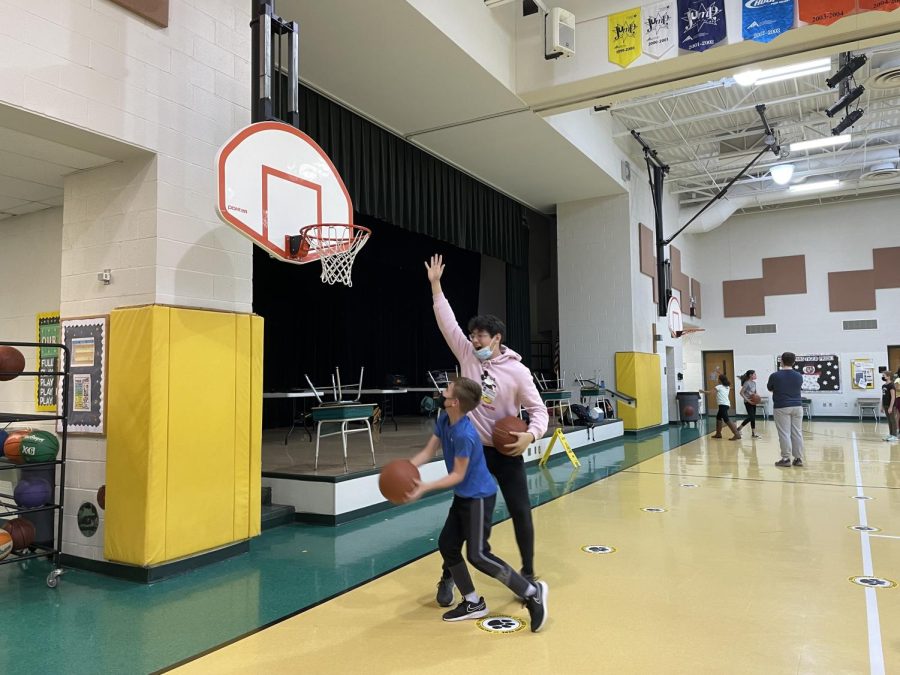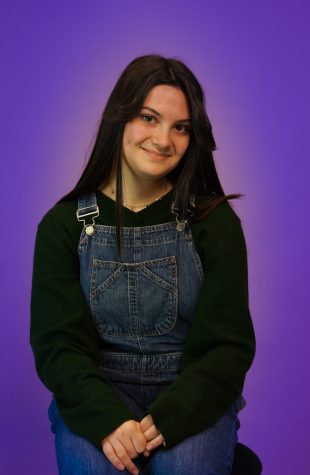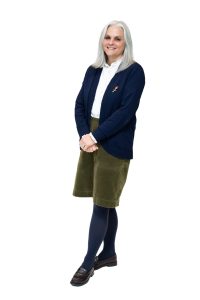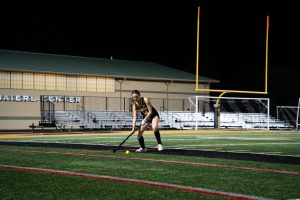Hoops at Hosack
The Hosack Elementary intramural basketball program offers elementary students the chance to combine exercise and socialization.
NHS member Felipe Bergerman plays a competitive game of knockout with a Hosack student.
March 3, 2022
Every Tuesday and Thursday after school, echoes of laughter can be heard in the gymnasium and multi-purpose room of Hosack Elementary School. The playful sounds are due to an intramural sports league held by fifth grade teacher, sponsor, and North Allegheny alum, Anthony Kremmel.
“I’ve been doing this for about seven years,” Kremmel said. “The year I started was the year I started doing this. No one really was able to do it, so I volunteered.”
While most elementary schools at North Allegheny have after-school programs like Hosack, the National Honor Society has been helping at Hosack since November. At first, the program focused on soccer but has now shifted to teaching students the game of basketball.
Senior Rachel Hockenberry attended the Hosack soccer program frequently and commented on the bonds she was able to build with the elementary students by volunteering.
“My favorite [part] is just getting to know the kids and learning their names,” she said. “Whenever you say it they’re really surprised.”
Senior Phillip Khoury agreed with Hockenberry’s statement about getting closer with students and making them feel special.
“My favorite memory was on my last day when I helped [a student] dunk and to see him be so happy,” he said. “It was great to connect with the kids.”
For elementary students, the program provides a place where they can relax and be with friends.
“I just thought it seemed fun to do it after school with friends,” said Elizabeth, a fifth grader at Hosack.
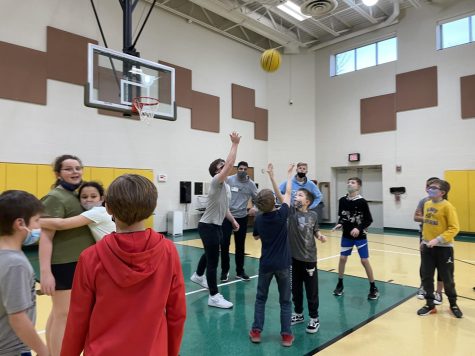
Students are taught different ways to get better at basketball during the intramurals. They learn games like knockout, as well as skills such as how to pass and how to take foul shots.
“To play the games is really fun,” said Tyler, a fourth grader. “It’s really fun to play with my friends.”
Students of all basketball levels were encouraged to attend. Some hailed from NABA origins, while others just wanted an activity to do after school.
“I played at a different organization, and I thought ‘Why don’t I play some more?’” said Emmett, a fifth grader. “So I decided to sign up.”
Like Emmett, Xavier had previous experience in the basketball domain.
“Well, it was in second grade when I first played,” said the fifth grader. “It was just kind of a fun thing to do. I didn’t have any other thing that I was signed up for at the time, so I just did [intramurals].”
Some students, however, signed up for the program solely based on word of mouth.
“I just heard that it was happening and I kind of like basketball so I just joined,” said a fifth grader named Elijah.
While others relax and use the basketball program as a way to let loose, Daanya, a fifth grader, uses the after school experience to sharpen her own basketball skills.
“I just like playing basketball and I like shooting hoops,” she said.
National Honor Society members reflected on their own elementary school athletics experiences.
“I played volleyball and flag football, and participated in intramurals [at McKnight],” said senior Cole Dorn. “Everyone I was around was supportive. I remember older students coaching my team and the impact they had when I first started playing sports. Even when they weren’t playing with us, they were someone to look up to.”
For NHS Vice President Maeren Quirke, connections with NABA drove her to help out with the program.
“Like most kids, I dabbled,” said Quirke, “I played soccer and swam, mostly with an after school program at the YMCA. I started NABA in fourth grade and that’s what stuck.”
Ironically, Mr. Kremmel, the program sponsor, did not have a basketball background growing up.
“It’s funny, the sports I usually did for intramurals were never the sports that I played as a kid,” he said. “I played baseball the most and did a little bit of hockey,”
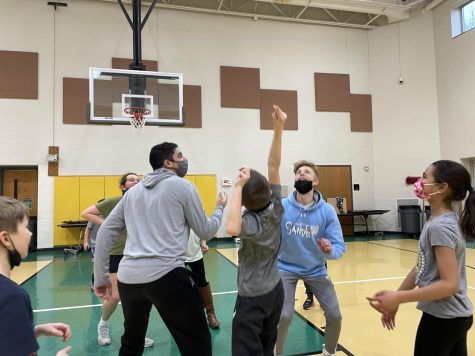
In past years, hockey has been included in the program. However, hockey specifically provides its own set of challenges and anxieties.
“We do a little bit of hockey every couple years, but it also is the one that makes me the most nervous because they have sticks that they whack each other in the leg with,” said Kremmel.
NHS members each have a different perspective on the program, and over time, begin to develop emotional attachments to the program and to students.
“Well, it’s always fun to watch the kids mess around. It’s a fun time,” said senior John Dowd.
The elementary students certainly provide loads of entertainment, as there is never a dull moment at the program.
“My favorite part of coming to Hosack was getting to meet each of the kids and see their excitement to play and improve,” said senior Ryan Barry. “But also Tyler making consistent 3’s at age 10 or so was pretty exciting too.”
“I liked playing with the kids,” said senior Caleb Schall. “Just working with them [and] cooperating with them is kind of fun. Seeing how they get better is really cool.”
Like Schall, Dorn also enjoyed interacting with the elementary students.
“Being able to build relationships with some of the students [was] my favorite part,” he said. “Hear[ing] about their day while teaching them how to shoot a basketball was truly enjoyable.”
Naturally, the large personalities of the students often result in rather boisterous moments, leading to memories many volunteers will never forget.
“My favorite memory is when one of the kids tried to show everyone how to do a layup, and he missed,” said Quirke.
For Kremmel, the sheer contrast of his students from inside to outside of the classroom is part of what makes the program stand out.
“I get to see kids much differently than in the classroom where we’re teaching math,” said Kremmel, “I’m the math teacher this year, so I get to see kids in a completely different way, and I would never have imagined how they act outside of that environment.”
Introducing students to sports at such a young age is shown to have vastly beneficial effects on their well-being in the future. According to the University of Minnesota, sports can aid students with “memorization, repetition, and learning–skillsets that are directly relevant to classwork.” Sports provide self-confidence, obvious health benefits, and improved problem-solving skills.
“We focus on being a team,” said Kremmel, “I always stress that winning is not the most important thing right now. They learn to understand that you’re going to lose, and it’s okay to not win every time. Some kids aren’t used to that.”
But perhaps most importantly, sports introduce kids to a social aspect that they simply would not be able to have in a classroom setting. They meet other students at their skill-level, all while endorphins are running high.
“It has been 11 years since I first started playing lacrosse and some of my best friends to this day are kids I met at practices when I was seven,” said Barry.
Not only is the elementary basketball program fun for the players, but it is fun for the sponsor and volunteers as well.


